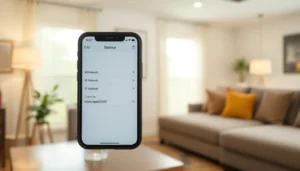Table of Contents
ToggleIn today’s tech-driven world, we’re all trying to squeeze out every ounce of data about our health and fitness. Enter biometric wearables, your shiny new best friend that can monitor everything from your heart rate to, believe it or not, your stress levels. If you’ve ever wondered if that fitness tracker can actually tell if you’re about to smash your personal best or just sit on the couch binge-watching your favorite show, you’re in the right place. This guide will jump into the intriguing realm of biometric wearables, so grab your favorite snack and let’s get started.
What Are Biometric Wearables?

Biometric wearables represent a leap into the future of personal health. These devices use advanced sensors to collect data related to biological phenomena. They can track heart rate, oxygen saturation, sleep quality, and even stress levels. Quite a change from those basic pedometers from yesteryear.
At their core, these gadgets are about more than just numbers. They aim to give users insights about their physiological states. With data pulled in real-time, users can make informed decisions about everything from exercise to daily nutrition. The idea is simple: the more you know about your body, the better you can treat it.
Types Of Biometric Wearables
The landscape of biometric wearables is ever-evolving, showcasing a variety of gadgets designed to fit multiple lifestyles.
Fitness Trackers
Fitness trackers are often the most recognized type. They typically monitor steps, heart rate, and sometimes even sleep metrics. Brands like Fitbit have revolutionized this sector, making it easy for anyone to start tracking.
Smartwatches
Smartwatches have taken biometrics to the next level. Devices from Apple, Samsung, and Garmin not only track fitness but also incorporate phone capabilities. These devices are like mini computers on your wrist, offering notifications and apps alongside health tracking.
Wearable ECG Monitors
More specialized wearables, like ECG monitors, focus on heart health. They offer continuous monitoring and can provide insights into heart rhythm, potentially detecting issues before they escalate.
Health Patches
Health patches, worn on the skin, can monitor various metrics non-invasively. They are gaining traction, especially in clinical settings, as they provide continuous data without the hassle of traditional devices.
How Biometric Wearables Work
Understanding the inner workings of biometric wearables can demystify why they are so effective. Essentially, these devices use sensors to gather data. Here are some of the technical aspects involved:
Sensors and Actuators
At the heart of every wearable lies an array of sensors. These sensors can include accelerometers, gyroscopes, and heart rate monitors. They work in tandem, gathering data as users go about their daily activities.
Data Transfer and Analysis
Once data is collected, it gets wirelessly transferred to smartphones or cloud servers. Here, algorithms analyze the raw data, transforming it into actionable insights that users can access via apps. The beauty of this process is that users can visualize their health metrics, making it easier to track progress.
User Interaction
Users interface with these devices primarily through apps, where they can view their statistics, set fitness goals, and even receive health recommendations. This feedback loop encourages a proactive approach to personal health.
Benefits Of Biometric Wearables
Biometric wearables offer a plethora of benefits that can significantly enhance an individual’s health journey:
Continuous Health Monitoring
One of the standout features is around-the-clock health monitoring. This constant tracking allows users to identify trends and recognize when something is off.
Motivation and Goal Setting
Wearables provide insights that can serve as a motivational tool. Seeing real-time progress can inspire users to reach their goals, whether that’s running a marathon or simply getting up more frequently.
Early Detection of Health Issues
With the ability to monitor vital signs and other metrics incessantly, wearables have the potential to spot health concerns early on. This can lead to timely intervention and better health outcomes.
Challenges And Limitations
Even though their many advantages, biometric wearables do face challenges:
Data Accuracy
While wearables can provide valuable data, they are not perfect. Factors such as user variability and environmental conditions can affect accuracy. Users should know that these devices are mainly intended for general insights rather than medical diagnoses.
Privacy Concerns
Security of health data is a growing concern. Wearable technology companies must prioritize data protection to maintain user trust. Users need to be aware of privacy policies and how their data is utilized.
Battery Life
Finally, battery life can be a limitation. Many wearables require frequent charging, which can be inconvenient for users looking for long-term, uninterrupted monitoring.
Future Trends In Biometric Wearables
The future looks promising for biometric wearables, with several trends likely shaping their evolution:
Integration with Healthcare Systems
As wearables become mainstream, integration with healthcare systems is becoming more common. It allows doctors to access real-time patient data, facilitating better-informed medical decisions.
Advanced Analytics
Improvements in artificial intelligence are making their way into wearables. This means more sophisticated algorithms can analyze data more effectively, offering deeper insights and predictions.
Personalization
The trend toward personalized healthcare will likely lead to even more tailored wearable solutions. Expect devices to adapt according to individual user metrics and preferences, making health management more effective.







